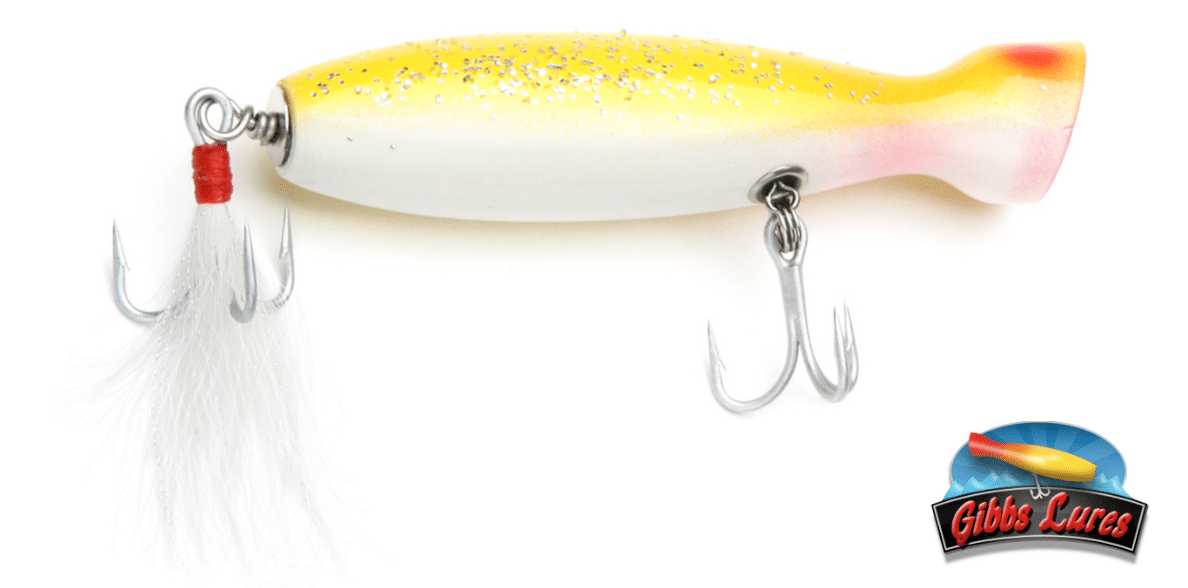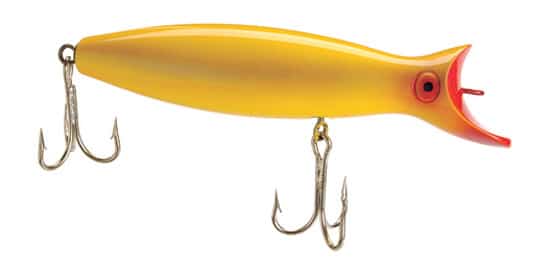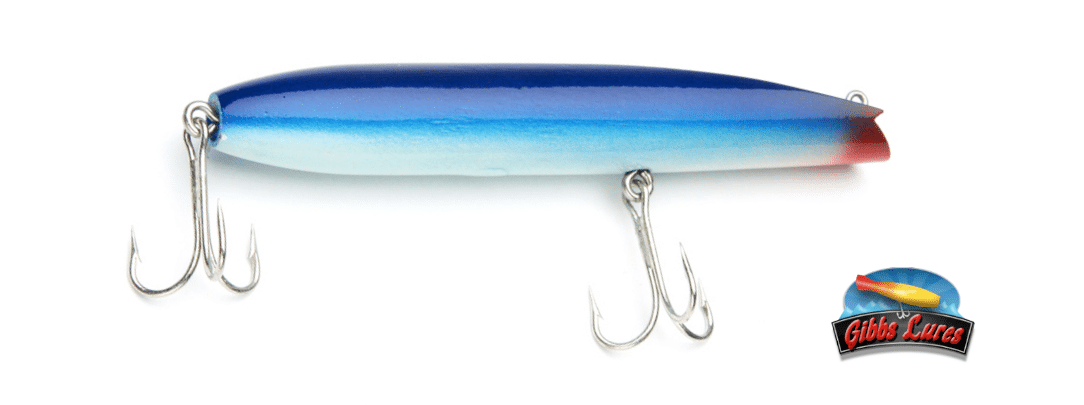“Polaris” or Bottle-Style Poppers

One of the most popular wooden poppers ever invented, the Polaris (made by Gibbs Lures) casts well in almost any conditions and lands with a fish-calling splash. They are available in weights ranging from ½ to 4 ounces and the most popular colors are white and yellow, although mackerel is also popular for fishing the Cape Cod Canal when tinker macks are present. Because of their weight and density it’s important to begin your retrieve almost the instant the lure hits the water so it doesn’t sink. If it does, reel quickly with the rod tip held high until it emerges again. Then continue to keep the rod fairly high and use an aggressive popping action. Reel a bit between pops to keep the line tight but be sure to make the plug throw water on each pop. Fish the lure right back to your feet – sometimes bass will follow for a maddeningly long way before committing to hit.
Pencil Poppers

Pencils are unique in that that don’t make a huge surface commotion like most other poppers and learning to fish them correctly does require a bit of practice. The object is to make them “walk” across the surface with a back-and-forth movement, at a fairly slow but steady rate. They are available form many manufacturers in both wood and plastic but most Cape Cod anglers prefer the wood versions. As with the Polaris-style poppers the most popular colors are white and yellow but also like the Polaris, canal anglers love the mackerel finish models and they are deadly effective at slack tide in the canal when mackerel are present. They are available in sizes ranging from ½ to 4 ounces and the larger versions cast very well.
Needlefish

Needles have a small but devoted following and these lures are used extensively along the beaches of the Outer Cape and also the Cape Cod Bay side, anywhere that sand eels are the predominant forage for stripers. Their name is an accurate description of their look: long, thin and with no swim plate on the nose. And this may be why some anglers try them and reject them without learning to fish them correctly. Needlefish move through the water in basically a straight line with no side to side motion at all – and in most cases the best retrieve is very slow. Anglers observe this and wonder why a bass would hit such an uninteresting looking bait. But the fact is, they do. Some of the biggest stripers taken over the years on the Outer Cape have fallen to Needles. They are available in sizes from only four inches long to almost a foot and savvy fishermen carry a wide assortment that will swim close to the surface or crawl along the bottom, or anywhere in between. White, yellow, amber and green are popular colors while black needles are used after dark.
Bottle-Style Swimmers

This is a very old design, wide and bulbous the rear with a tapered neck and a wider, scooped nose section, which is what gives them their seductive wobble. Although not as popular asthey once were you will still see them used along the Cape Cod Canal, most often when the current is running fairly hard. They are an excellent choice when larger baits such as herring or menhaden are present. The most common sizes used are 2 to 4-ounces and white, yellow and mackerel are preferred colors.
Darters

Although not quite as popular as they farther to the south in places such as Montauk and Block Island, darter are used in the canal and around outflows where some current and depth are present. Their erratic, darting action comes from their flat, slanted head and v-cut mouth. They cast very well in the larger sizes (2 to 4-ounces) and are fun to fish because the angler must vary his retrieve and rod angle to achieve the best darting action. All the standard colors (white, black, amber, mackerel) are popular.
Danny-Style Surface Swimmers

Perhaps the most popular and productive wooden lure used by savvy fishermen in places without a lot of current is the Danny, named for its inventor, the late Danny Pichney. These lures feature a wide, bent metal lip and a fairly light body, which allow them to be slowly (and that is key!) retrieved across the surface. The correct retrieve of Dannys definitely needs to be practiced. A Danny that is constructed perfectly and fished correctly will waddle along the surface with a side-to-side movement with very little rolling action. You must reel painfully slow but fast enough so the plug doesn’t sink (although there are designs of Dannys that are meant to sink, most often used when trolling) with your rod tip held high. When swimming perfectly in smooth water – these lures are never used in choppy conditions – a Danny will give off a smallwake like a little motorboat moving along the surface. When stripers hit Dannys they do so with amazing violence, so much so that the angler must be sure to wait until he actually feels the weight of the fish rather than reacting to the hit itself. Dannys range in weight from 1 to about 3 ounces and basic solid colors are best, although many garage plug builders make examples with complex and beautiful colors and finishes. A black Danny fished in a Cape Cod estuary in the dead of night can result in some unforgettable catches. Unfortunately, because of their shape and relatively light weight they do not cast particularly well but that may be a tradeoff that is well worth taking!

















